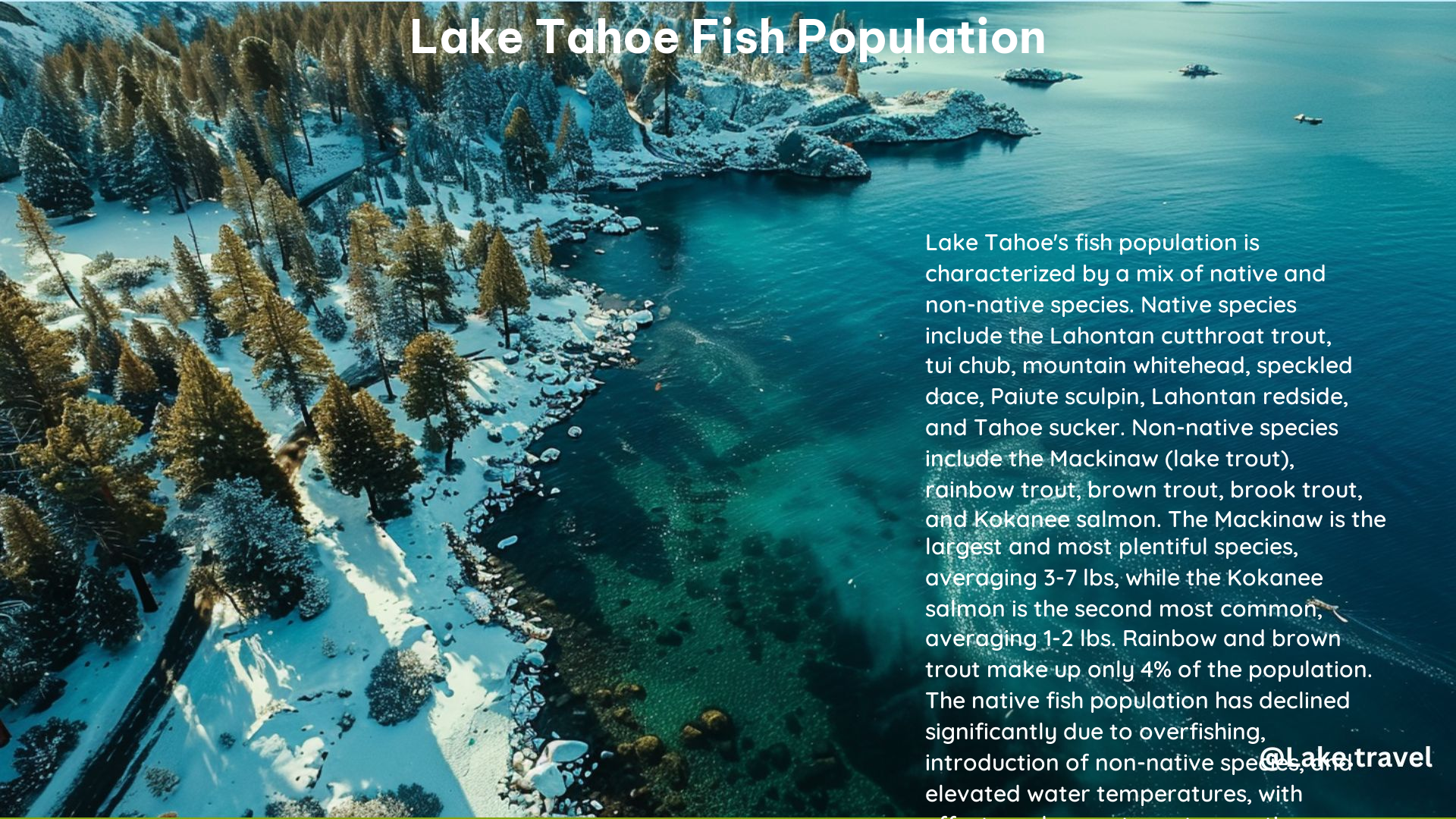Lake Tahoe, a stunning alpine lake nestled in the Sierra Nevada mountains, is renowned for its crystal-clear waters and diverse ecosystem. As a Lakes Touring Enthusiast, I’m excited to share the fascinating details about the fish population that call this remarkable body of water home.
Current Status of Native Fish Species
The native fish species in Lake Tahoe have faced significant challenges over the years, with a concerning decline in their population. A study conducted by the University of Nevada, Reno, revealed that the density of native fish species has decreased by a staggering 58% since 1951, with some locations showing no native species at all.
The native fish species found in Lake Tahoe include:
- Lahontan Cutthroat Trout
- Speckled Dace
- Paiute Sculpin
- Lahontan Redside
- Tahoe Sucker
These species are an integral part of the lake’s delicate ecosystem, playing a crucial role in maintaining the balance of the food web. Their decline is a concerning issue that requires immediate attention and conservation efforts.
Impact of Non-Native Fish Species

The introduction of non-native fish species has had a significant impact on the native fish population in Lake Tahoe. Several coldwater sport fish, such as Mackinaw, rainbow, brown, and brook trout, were intentionally introduced to the lake to support recreational fishing. Additionally, the Kokanee salmon was introduced in the 1940s, and the Mackinaw trout was introduced in 1894, leading to the extinction of the native Lahontan cutthroat trout in 1939.
The presence of these non-native species has disrupted the lake’s ecosystem, altering the food web and contributing to the decline of the native fish population. The Mackinaw trout, in particular, has been identified as a significant threat to the native species.
Furthermore, the lake has also been affected by the introduction of invasive species, such as largemouth bass and bluegill, which were illegally introduced. These invasive species have further exacerbated the decline of native fish and continue to pose a threat to the overall ecological balance of Lake Tahoe.
Conservation Efforts
In response to the concerning decline of native fish species, various conservation efforts have been initiated to protect and restore the lake’s fish population.
-
Management Plan: A management plan has been proposed to focus on the protection of the nearshore zone habitat, which is critical for the survival of native fish species. The plan aims to reduce the impact of non-native species and implement strategies to revive the native fish population.
-
Ultraviolet Attainment Threshold (UVAT): Researchers have suggested the use of UVAT as a metric to assess the nearshore fishery. UVAT measures the intensity of ultraviolet radiation, which affects the survival of non-native species. This metric can help in developing targeted strategies to control the spread of invasive species and promote the recovery of native fish.
-
Fish Stocking: Efforts are being made to reintroduce native species into Lake Tahoe. In 2022, for example, 100,000 fish were stocked into the lake to aid in the restoration of the native fish population.
Fishing in Lake Tahoe
Lake Tahoe is a popular destination for anglers, with a diverse array of fish species available for recreational fishing. The most common fish species found in the lake include:
- Mackinaw Trout
- Kokanee Salmon
- Rainbow Trout
- Brown Trout
These species are often targeted by fishing enthusiasts, and various fishing charters and guides operate in the area to provide an enjoyable and sustainable fishing experience.
It’s important to note that fishing regulations are in place to protect the lake’s ecosystem. Anglers must adhere to these guidelines and restrictions to ensure the long-term sustainability of the fish population.
Conclusion
Lake Tahoe’s fish population is a complex and dynamic ecosystem that has faced significant challenges over the years. The decline of native species and the impact of non-native and invasive species have disrupted the delicate balance of the lake’s ecosystem. However, conservation efforts are underway to protect and restore the native fish population, ensuring the continued enjoyment and appreciation of this remarkable natural wonder.
As a Lakes Touring Enthusiast, I encourage you to explore the beauty of Lake Tahoe and learn more about the fascinating fish that call this lake home. By understanding the importance of preserving the native species and supporting sustainable fishing practices, we can all play a role in safeguarding the future of this incredible ecosystem.
References
- University of Nevada, Reno – Tahoe Native Fish Population Falls Sharply, Invasives Increase
- Tahoe Sport Fishing – What Types of Fish are in Lake Tahoe?
- USDA Forest Service – Land Management and Resource Management
- Discovery – Lake Tahoe is Getting its Fish Back
- Mountain Democrat – Tahoe Native Fish Numbers Decline
